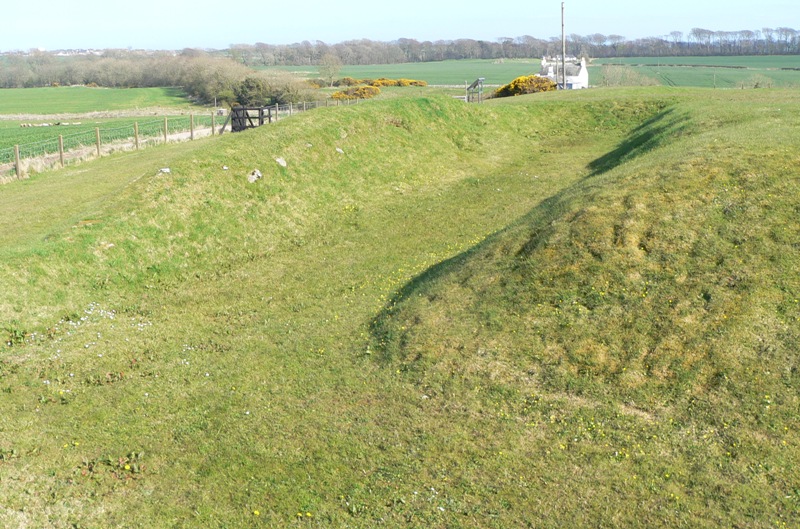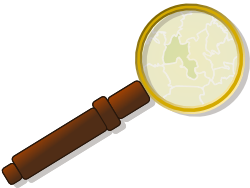Search the Gazetteer
Are the results not as expected? Modify your search term or change the scope to refine your search.
Results for a place that exactly matches ...
Wigtownshire
Wigtownshire, Scotland
Wigtownshire is a maritime county in the far south-west of Scotland, between the Solway Firth and the North Channel. The west of the county is comprised of the hammer-headed peninsula the Rhinns of Galloway. The rounded northern headland ends at Milleur Point and the southern headland is the Mull of Galloway. Between the Rhinns and the main body of the county are two bays; Luce Bay a broad expanse to the south with 10 miles of sheltered sandy beach, and the more enclosed Loch Ryan to the north, along which are the ferry ports Stranraer and Cairnryan. The south-east of the county comprises The Machars, a great triangular peninsula between Wigtown Bay and Luce Bay. At the southern end is Whithorn, once site of a major Anglo-Saxon abbey. Wigtown itself, at the top of Wigtown Bay, has numerous second-hand bookshops. Newton Stewart spills over the River Cree into Kirckcudbrightshire. In the north-east, the county trespasses into the Southern Uplands.
Portrait of Wigtownshire
Place Type: Historic County
Lat, Long: 54.919584,-4.619674
Grid Reference: NX322614
Country: Scotland
GBPNID: 305813
Entry Type: Main listing (P)
URL: https://gazetteer.org.uk/place/Wigtownshire
 Explore Wigtownshire on Wikishire
Explore Wigtownshire on Wikishire
The west of the county is comprised of the hammer-headed peninsula The Rhinns of Galloway. The Rhinns or Rhins are a hilly ridge running almost north-south and joined to the main body of the county in their midst. The rounded northern headland ends at Milleur Point and the southern headland is the Mull of Galloway, Scotland's southernmost point. Between the Rhinns and the main body of the county are two bays; Luce Bay a broad expanse to the south with 10 miles of sheltered sandy beach, and the more enclosed Loch Ryan to the north, at the head of which is Stranraer and further north Cairnryan, two ferry ports taking advantage of the shelter of the loch. Dunskey Castle is a ruined, 12th-century tower house near Portpatrick on the west coast of the Rhinns.

Dunskey Castle on the west coast of the Rhinns of Galloway
The south-east of the county comprises The Machars, a great triangular peninsula between Wigtown Bay and Luce Bay. This land has no notable hills but is a gently rolling landscape. The village of Glenluce lies a little inland from the top of Luce Bay. The Castle of Park is a 16th-century L-plan tower house near Glenluce. Also nearby are the ruins of Glenluce Abbey, a Cistercian monastery founded around 1190. Carsreugh Castle is a ruined 17th century castle standing on lands once owned by the Abbey.

Glenluce Abbey
Whithorn is a town and royal burgh standing a little inland, close to the end of The Marchars promontory. The town was the location of the first recorded Christian church in northern Britain, named Candida Casa; the 'White House', built by Saint Ninian in 397. A monastery and diocese of the Anglo-Saxon kingdom of Northumbria was founded on the site in the 8th century. The cathedral priory is now ruinous. Whithorn's link to the sea was the port known as the Isle of Whithorn, used in the Middle Ages by pilgrims arriving by boat. The thirteenth-century St Ninian's Chapel marks the point where pilgrims came ashore.

St Ninian's Chapel, Isle of Whithorn
The Machars peninsula is rich in prehistoric remains, most notably the Torhousekie Standing Stones, a neolithic stone circle aligned to the winter solstice. Rispain Camp is the remains of an Iron Age fortified farmstead a mile west of Whithorn.

Rispain Camp
Wigtown Bay is a formed of the estuary of the modest River Cree and that of the Water of Fleet, and it divides Wigtownshire from Kirkcudbrightshire. Wigtown, the county town, is at the top of Wigtown Bay. It has gathered a large collection of second-hand bookshops and is known as 'Scotland's National Book Town'.

Wigtown Bay from Wigtown Harbour
On the eastern border with Kirkcudbrightshire is the town of Newton Stewart, "The Gateway to the Galloway Hills". The town spills over the River Cree which forms the county border.
In the north-east, the county trespasses into the Southern Uplands, though only towards the Ayrshire border do the hills reach a considerable altitude. Craigairie Fell at 1,056 feet is the county top.

Craigairie Fell from Loch Derry
Around the 6th century Wigtownshire was part of the kingdom of Strathclyde. The area was invaded by both Anglo-Saxons from the neighbouring kingdom of Northumbria and by Scots from Ireland. During the 9th century, Norse invaders and settlers grew to dominance and the area became part of Galloway, a district that was ruled by Scots-Norse kings. The Lords of Galloway maintained Galloway's independence by shifting their allegiance between Scottish and English kings. When Alan, Lord of Galloway, died in 1234 the 'Community of Galloway' wanted his illegitimate son Thomas as their king. Alexander III of Scotland supported the cause of his daughters and invaded Galloway. The Community of Galloway was defeated, and Galloway divided up between Alan's daughters, thus bringing Galloway's independent existence to an end. Alan's eldest daughter, Devorguilla, married John de Balliol, and their son subsequently became King John I of Scotland. The bloody wars that followed were disproportionately fought in Galloway. Wigtownshire was constituted a shire in the thirteenth century. The Industrial Revolution largely bypassed Wigtownshire, which remains overwhelmingly pastoral, though tourism is now a major industry.
Portrait of Wigtownshire
Place Type: Historic County
Lat, Long: 54.919584,-4.619674
Grid Reference: NX322614
Country: Scotland
GBPNID: 305813
Entry Type: Main listing (P)
URL: https://gazetteer.org.uk/place/Wigtownshire
 Explore Wigtownshire on Wikishire
Explore Wigtownshire on WikishireThe west of the county is comprised of the hammer-headed peninsula The Rhinns of Galloway. The Rhinns or Rhins are a hilly ridge running almost north-south and joined to the main body of the county in their midst. The rounded northern headland ends at Milleur Point and the southern headland is the Mull of Galloway, Scotland's southernmost point. Between the Rhinns and the main body of the county are two bays; Luce Bay a broad expanse to the south with 10 miles of sheltered sandy beach, and the more enclosed Loch Ryan to the north, at the head of which is Stranraer and further north Cairnryan, two ferry ports taking advantage of the shelter of the loch. Dunskey Castle is a ruined, 12th-century tower house near Portpatrick on the west coast of the Rhinns.

Dunskey Castle on the west coast of the Rhinns of Galloway
The south-east of the county comprises The Machars, a great triangular peninsula between Wigtown Bay and Luce Bay. This land has no notable hills but is a gently rolling landscape. The village of Glenluce lies a little inland from the top of Luce Bay. The Castle of Park is a 16th-century L-plan tower house near Glenluce. Also nearby are the ruins of Glenluce Abbey, a Cistercian monastery founded around 1190. Carsreugh Castle is a ruined 17th century castle standing on lands once owned by the Abbey.

Glenluce Abbey
Whithorn is a town and royal burgh standing a little inland, close to the end of The Marchars promontory. The town was the location of the first recorded Christian church in northern Britain, named Candida Casa; the 'White House', built by Saint Ninian in 397. A monastery and diocese of the Anglo-Saxon kingdom of Northumbria was founded on the site in the 8th century. The cathedral priory is now ruinous. Whithorn's link to the sea was the port known as the Isle of Whithorn, used in the Middle Ages by pilgrims arriving by boat. The thirteenth-century St Ninian's Chapel marks the point where pilgrims came ashore.

St Ninian's Chapel, Isle of Whithorn
The Machars peninsula is rich in prehistoric remains, most notably the Torhousekie Standing Stones, a neolithic stone circle aligned to the winter solstice. Rispain Camp is the remains of an Iron Age fortified farmstead a mile west of Whithorn.

Rispain Camp
Wigtown Bay is a formed of the estuary of the modest River Cree and that of the Water of Fleet, and it divides Wigtownshire from Kirkcudbrightshire. Wigtown, the county town, is at the top of Wigtown Bay. It has gathered a large collection of second-hand bookshops and is known as 'Scotland's National Book Town'.

Wigtown Bay from Wigtown Harbour
On the eastern border with Kirkcudbrightshire is the town of Newton Stewart, "The Gateway to the Galloway Hills". The town spills over the River Cree which forms the county border.
In the north-east, the county trespasses into the Southern Uplands, though only towards the Ayrshire border do the hills reach a considerable altitude. Craigairie Fell at 1,056 feet is the county top.

Craigairie Fell from Loch Derry
Around the 6th century Wigtownshire was part of the kingdom of Strathclyde. The area was invaded by both Anglo-Saxons from the neighbouring kingdom of Northumbria and by Scots from Ireland. During the 9th century, Norse invaders and settlers grew to dominance and the area became part of Galloway, a district that was ruled by Scots-Norse kings. The Lords of Galloway maintained Galloway's independence by shifting their allegiance between Scottish and English kings. When Alan, Lord of Galloway, died in 1234 the 'Community of Galloway' wanted his illegitimate son Thomas as their king. Alexander III of Scotland supported the cause of his daughters and invaded Galloway. The Community of Galloway was defeated, and Galloway divided up between Alan's daughters, thus bringing Galloway's independent existence to an end. Alan's eldest daughter, Devorguilla, married John de Balliol, and their son subsequently became King John I of Scotland. The bloody wars that followed were disproportionately fought in Galloway. Wigtownshire was constituted a shire in the thirteenth century. The Industrial Revolution largely bypassed Wigtownshire, which remains overwhelmingly pastoral, though tourism is now a major industry.


 Menu
Menu